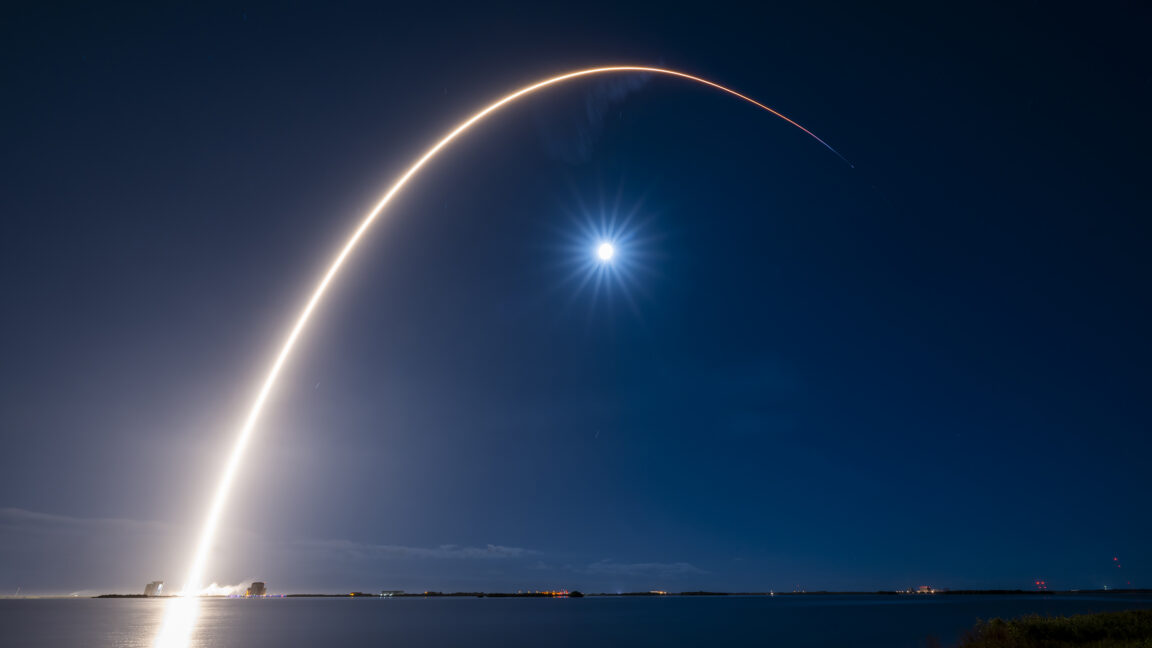The FAA has directed commercial airlines to reduce domestic flights from 40 “high impact airports” across the country in a phased approach starting Friday. This order, issued by FAA Administrator Bryan Bedford, aims to address “safety risks and delays presented by air traffic controller staffing constraints caused by the continued lapse in appropriations.”
As air traffic controllers are considered essential workers, they continue to perform their duties without pay until Congress passes a federal budget and President Donald Trump signs it into law. While the shutdown initially impacted federal workers most severely, its effects are now spreading across the broader economy.
### Sharing the Airspace with Space Vehicles
Vehicles traveling to and from space share the skies with aircraft, requiring close coordination with air traffic controllers to clear airspace for rocket launches and reentries. The FAA’s order restricting commercial air traffic, launches, and reentries aims to “ensure the safety of aircraft and the efficiency of the [National Airspace System].”
In a statement, the FAA described the air traffic control system as “stressed” due to the shutdown. The agency highlighted that “continued delays and unpredictable staffing shortages, which are driving fatigue, risk is further increasing,” raising concerns about the system’s capacity to maintain the current volume of operations. “Accordingly, the FAA has determined additional mitigation is necessary,” the statement added.
### New Launch and Reentry Restrictions
Beginning Monday, the FAA will permit commercial space launches only between 10 p.m. and 6 a.m. local time, when the national airspace is at its calmest. Commercial reentries will also be restricted to this overnight timeframe. The FAA licenses all commercial launches and reentries, and launch times depend on several factors, most notably the mission’s destination.
For example, launches heading to specific orbits, such as that of the International Space Station (ISS), have narrow daily launch windows. The ISS follows an orbital path fixed relative to the Earth, and the planet’s rotation brings a spaceport under the station’s orbital plane at specific times each day. This timing determines when a rocket can launch toward the ISS.
### SpaceX and Other Launch Schedules
SpaceX is the most active U.S. launch company, with most of its Falcon 9 rocket launches deploying Starlink internet satellites. With nearly 9,000 active satellites flying in various orbital planes at different altitudes and inclinations, SpaceX has some flexibility to schedule nighttime launches to comply with the FAA curfew.
However, not all missions have flexible launch windows. Blue Origin’s New Glenn rocket is scheduled to launch at 2:45 p.m. EST on Sunday from Cape Canaveral Space Force Station, Florida. This mission will deploy two NASA satellites en route to Mars, and its specific trajectory requires an afternoon launch.
Since NASA contracted this launch commercially through Blue Origin, it falls under FAA licensing. It is currently unclear whether NASA could request a waiver if the launch is delayed into next week. Transportation Secretary Sean Duffy, who also serves as NASA’s acting administrator, may face the unique situation of potentially requesting and granting such a waiver.
Another commercial SpaceX launch is scheduled for Tuesday to deploy several small satellites into a Sun-synchronous orbit. This mission requires a late-morning launch from Vandenberg Space Force Station, California. Originally planned for shortly after 10 p.m. local time in Florida, the launch window shifts earlier each day and may soon fall within the FAA’s curfew period, potentially causing further delays.
### Upcoming Missions Unaffected by Restrictions
Several upcoming missions are expected to remain unaffected by the FAA’s restrictions. These include the launch of a U.S.-European oceanography satellite later this month on a Falcon 9 rocket, which is authorized by NASA and does not require an FAA license. The same applies to launches conducted for the U.S. Space Force.
Rocket Lab, a U.S.-based company regulated by the FAA, confirmed that launches from its primary spaceport in New Zealand are “unaffected” by the restrictions since they do not operate within U.S. airspace.
### Impact on NASA and Artemis II Mission
The government shutdown is also taking a toll on NASA. Ground crews at Kennedy Space Center in Florida continue preparations for the Artemis II mission, scheduled for early next year to send astronauts near the Moon for the first time in over 50 years. However, both civil servants and contractors are working without pay, and officials anticipate the shutdown will eventually affect the Artemis II schedule.
### Ongoing Government Shutdown and Political Stalemate
Lawmakers in Washington, D.C., are negotiating to end the shutdown, but there is no clear timeline for a resolution. Democrats in Congress are pushing to extend expiring tax credits to lower health insurance premiums and are protesting proposed Medicaid cuts.
This ongoing impasse recently became the longest government shutdown in U.S. history, further highlighting the challenges faced by federal agencies, workers, and the broader economy.
https://arstechnica.com/space/2025/11/faa-says-commercial-rockets-must-launch-at-night-citing-government-shutdown/



